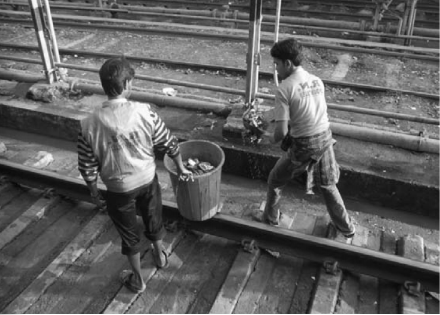Caste: The Ugly Side Of the Indian Railways

From April 14, we are likely to see the government celebrate Ambedkar's birth anniversary. With this post we begin a series of stories that don't just look at Ambedkar's life, but also what he stood for. We have to remember that the government's non-acnowledgement of caste, against which Ambedkar launched a crusade in his lifetime, is still pervasive. One such caste-blind policy launched by the BJP-led government was the Swachh Bharat Abhiyan. It refused to acknowledge the continued existance of manual scavengers in India. It is the government — the Indian Railways, to be more precise — that employs the highest number of manual scavengers.
To remember this fact, we publish an extract from Bhasha Singh's book, Unseen: The Truth About Manual Scavenging. This particular section is from the chapter "Indian Railways and Manual Scavenging." The book was published by Penguin in 2012.
A young man was standing over the railway tracks near the platform at the Anand Vihar railway station in New Delhi, the capital city of India. He had a broom in his hand. Another young man standing nearby held a pipe. Sachin and Rehan both hail from the north Indian state of Bihar. Both of them work on a contract basis to clean the human excrement that falls on the tracks near the platform when a train passes by. And not just that, they are involved in other activities like rag picking and sweeping too. They work for a contractor who belongs to Delhi and has the contract for the cleaning and sanitation of this particular railway station.
There are many other young boys like Sachin and Rehan who work for the contractor and their numbers keep fluctuating from time to time. These are the manual scavengers of the mighty Indian Railways, who work under its very nose but are still invisible. They could answer to any Indian name, could hail from any state, and this could be the platform of any railway station in the country, so ubiquitous is this sight. There is no alternate way to dispose of human excrement from moving or stationed trains except through human engagement.
No one can deny this bitter reality because it is right there in front of us. It stares in the face of the 2.3 crore passengers that travel in trains every day (Source: Railway Budget 2012–13). But in spite of such blatant evidence, for the last ten years (since 2003), in the course of the hearing of the public interest litigation in the Supreme Court and in the Delhi High Court, the railways have continuously been presenting an affi davit stating that it does not employ any manual scavengers. There was only one exception to this when in 2005 it had admitted the presence of manual scavengers, but then it again went back on its word. It holds true not only for the railways but for the entire administrative system that instead of using all their power to eradicate the horrible practice of manual scavenging they use it to deny its very existence. The fact that the railways do not directly employ most of its sanitary workers or safai karamcharis—instead they work on a contract basis and therefore their presence is not registered in any records—is used by it as an effi cient smokescreen.
The railways has been blatantly lying about the presence of manual scavengers in its workforce based on this false evidence, whereas the truth is that at many places even railway employees, who are officially known as safai-wallahs, are doing the work of manual scavenging. I have seen safai-wallahs, appointed by the railways, scavenging excrement from the railway tracks with my own eyes at Jalandhar and Ludhiana in Punjab, Ajmer and Nasirabad in Rajasthan, Ambala in Haryana, Jabalpur in Madhya Pradesh, Secunderabad in Andhra Pradesh and Gulbarga in Karnataka. The Safai Karmachari Andolan has, in the course of the hearing of its PIL, handed over statements by many such safai-wallahs stating they do indeed work as manual scavengers for the railways. The question is not whether the workers doing manual scavenging for the railways are contract labour or its own employees. The question is whether they are manually cleaning the human excrement from the railway tracks or not. The Act that was formulated twenty years ago, in 1993, for preventionof manual scavenging does not differentiate between contract labour, daily wagers or permanent employees. It just focuses on the fact that someone is practising manual scavenging and that not only is it unlawful t o do so, but it is the responsibility of the state to ensure that manual scavengers are rehabilitated in professions that allow them to keep their dignity. In simple words, it means that the railways cannot wish away or wash its hands off this issue and it has to find ways and means to collect excrement from the tracks by mechanized means. The logistics of it all is mind-boggling—each day 12,000 passenger trains run across the length and breadth of India, they pass through or halt at railway stations, their toilets are repeatedly used and the excrement keeps falling on to the tracks. If human beings are not cleaning this filth, then who is? On one hand, Indian Railways has not been able to provide a reply to the question about the disposal of excrement. On the other hand, it hasn’t made any moves to mechanise the process, nor has it installed bio-toilets in trains. Then who is cleaning it all up? In fact, the story of manual scavenging in the railways is a test case of how issues can be dragged in a democracy, how one can keep beating about the bush for years and years, skirting the real issues. And finally nothing comes out of the whole exercise. Let us begin this filthy story of the railways from today and gradually proceed to the past.
According to the affidavit fi led in the Delhi High Court by Indian Railways in 2012, only 504 bio-toilets have been installed in nine trains in the country. This means that only nine trains don’t litter the track with filth. Then how many trains do leave the filth on the tracks?
[…]
One thing that emerges clearly from whatever the railways says and has been saying is that it definitely is in no hurry to free itself of manual scavengers and its lackadaisical approach is openly manifest in the decade-long, (which may eventually stretch to more than a decade) plans that it has drafted. But then, in the affidavit filed before the court, it always negates the presence of manual scavengers in its system. In the PIL fi led in the Supreme Court for the implementation of the Employment of Manual Scavengers and Construction of Dry Latrines (Prohibition) Act, 1993, Indian Railways too is cited as one of the defendants. This petition was fi led in 2003 and the case against Indian Railways is subsequently pending in the Delhi High Court since 2011. There hasn’t been any significant change in the attitude of the railways over the years. It always has the same story—there is much talk about developing a new technique and then soon it is dismissed. In the year 2013, there is not even one railway station that can claim that it is using some mechanized means, not human beings, to clean the excrement from the tracks.
The Changing Statements
In 2005, Indian Railways said that it did not have any technique whatsoever to stop the excrement from falling on the tracks from the toilets in railway coaches. Therefore it said that it will convert the tracks that pass through railway stations into cement aprons because normally the tracks are laid with gravel and only safai karamcharis are able to clean the excrement from them with their hands. If cement is laid instead of gravel, then, after a train leaves, water jets can be used to wash the fallen excrement away and thus the need for human beings to use their hands for the job will be done away with. There was also talk of providing the safai karamcharis with gumboots and gloves. What is remarkable is that fifty years ago, in 1963, the Malkani and Barve committees had made the same recommendations that manual scavengers be provided with gloves and gumboots. The railways was saying the same thing in 2005, which means nothing had been done in this direction from 1963 to 2003. It did not have any solution for this problem because it never saw it as a problem in the first place. Instead of abolishing it, all the energy was used to sweep this filth under the carpet.
[…]
Now let us take a look at the stations where the cement aprons have been constructed. Why begin with far-flung railway stations of Uttar Pradesh, Bihar, Chennai, Tamil Nadu, Punjab or Haryana? The truth about cement aprons is unmasked right in the heart of the country, strolling through the various railway stations of the national capital. The ground reality here, in fact, has been mentioned at the beginning of this chapter and there are photographs to dispel all doubts. Whether it is the Anand Vihar railway station or New Delhi railway station, safai karamcharis cleaning the tracks with a broom can be seen everywhere. When asked why they don’t use the jets, Sunil said that the excrement is not properly cleaned with the water jets and the broom has to be used. And the drains, which run next to the track to take the filthy water away, are so narrow that they often get clogged. It is diffi cult to clean them even with a broom, let alone a jet. At Chennai’s Egmore railway station one could see a large number of women cleaning the tracks. One woman poured water from a plastic pot while the other swept the muck into the drain. This is the bitter reality behind the much-touted cement aprons. But, at present, the railways has forgotten all about cement aprons too and makes no mention of it any more. For after spending crores on them it has realised that this technique does not work. Amidst these various revelations, the practice of manual scavenging continues unhindered on the railway tracks all over the country.
In the affidavit filed by it before the Supreme Court in October2006, the railways, after the failed and expensive cement-apron experiment, now talked about installing the controlled discharge toilet system (CDTS). In this technology, the excrement from the toilets in the coaches gets collected in a tank under the coach, instead of falling on to the tracks. After leaving the railway station, when the train attains a speed of 60 km/h, the driver of the train releases the opening of the tank. The tanks attached to each coach will open up and spill their contents on to the tracks. The railways thought that if this filth is thrown on to the tracks far away from a railway station, there would be no need to clean it. It would just flow away here and there or dry up. It was claimed in the affidavit that the railways would convert 1000 toilets every year, at a cost of `20 crore to CDTS. It is amusing to note that the railways has itself claimed in its affidavit that the use of CDTS is harmful to the environment.
How ironic it is that the railways is coming up one after the other with techniques which don’t seem to have been tried and tested anywhere else. It was observed that in the trains where CDTS had been installed the excrement would spread along and stick to the undersides of the railway coaches and, due to the wind, also in the spaces between coaches. Clearly it turned out to be a system that spread the filth and the foul smell further, rather than helping to curtail it in any way. It also became a torment for those happening to live in localities near railway tracks. It seems unbelievable, but the stinking truth is that the railways is definitely spreading its filth far and wide.
[…]
After this report, the railways turned its attention to biotoilets.In a bio-toilet, there is a tank attached to the toilet which contains some enzymes and bacteria to degrade the excrement, though the railways has not yet made public the information as to how exactly it disposes of this degraded waste. When questions began to be raised about the working of bio-toilets, the Delhi High Court appointed senior attorneys Rajiv Nanda and P.S. Narsimha as amicus curiae to investigate the matter. They were charged with finding out how the bio-toilets installed in Rewa Express actually worked and whether they were fulfilling the purpose for which they had been installed in the first place. The amicus curiae submitted their first report without even having a look at this train. Then the court instructed them to travel in the train and subsequently submit their report. The final report that was submitted said that if a stone or cloth is disposed off in the bio-toilet, it doesn’t work. And otherwise too, there is always the chance that it will get choked. When it gets choked, it cannot be opened without human intervention. Which means that things don’t work smoothly even with the bio-toilet. Amidst these concerns about bio-toilets, the railways is, as it is, only inching towards their installation in coaches. Only the high-end trains like Rajdhanis have the privilege of having them yet.
[…]
There seems to be no liberation for these manual scavengers who work for the railways. By not even acknowledging their presence, the railways has ensured that this inhuman practice continues. And thus the country will never be entirely free from manual scavenging.
Bhasha Singh is a writer, journalist and activist. She has written widely on manual scavenging. Her book, Unseen: The Truth about India's Manual Scavengers, originally written in Hindi as Adrishya Bharat. Her book has been translated into many languages.
Get the latest reports & analysis with people's perspective on Protests, movements & deep analytical videos, discussions of the current affairs in your Telegram app. Subscribe to NewsClick's Telegram channel & get Real-Time updates on stories, as they get published on our website.
























